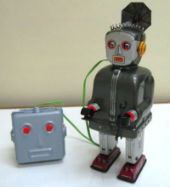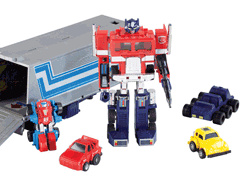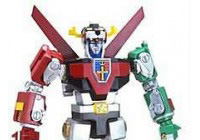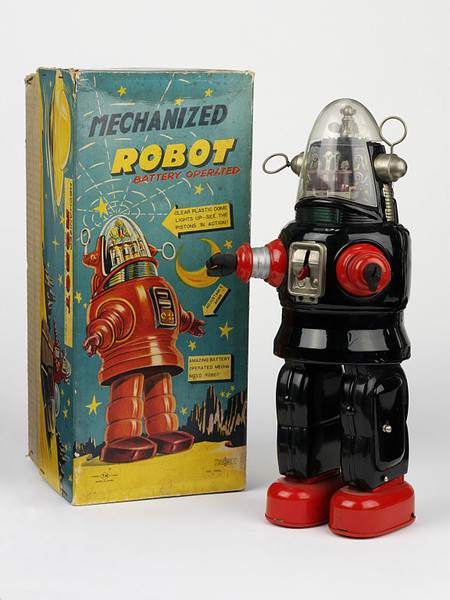 This Winter’s 2017 Wonder Festival Toy Convention (aka “Wonderfes”) featured an incredible showcase of action figures, model kits, and robotic toys. These robot toys, commonly known by collectors as “mecha,” are popular with Japanese toy collectors. The interest for these robotic collectibles has crossed the Pacific, attracting a large fan base in North America. This fascination for mecha toys and mechanized action figures can be traced back several decades to the years after the World War II. Let us now for a moment take a step back and review the history of vintage toy robots in Japan and the USA.
This Winter’s 2017 Wonder Festival Toy Convention (aka “Wonderfes”) featured an incredible showcase of action figures, model kits, and robotic toys. These robot toys, commonly known by collectors as “mecha,” are popular with Japanese toy collectors. The interest for these robotic collectibles has crossed the Pacific, attracting a large fan base in North America. This fascination for mecha toys and mechanized action figures can be traced back several decades to the years after the World War II. Let us now for a moment take a step back and review the history of vintage toy robots in Japan and the USA.
 During the 1930’s and 1940’s, the industries in Japan heavily invested a vast majority of their natural resources for the war. Their government ruled by the military stripped several major landmarks constructed of steel and precious material for use in the war efforts. Due to this circumstance, most of the manufactured products in Japan during those periods were composed of low quality material and manufactured with lower standards. Meanwhile in the United States, businesses such as Marx and Gilbert lobbied that the country should continue to produce toys for children.
During the 1930’s and 1940’s, the industries in Japan heavily invested a vast majority of their natural resources for the war. Their government ruled by the military stripped several major landmarks constructed of steel and precious material for use in the war efforts. Due to this circumstance, most of the manufactured products in Japan during those periods were composed of low quality material and manufactured with lower standards. Meanwhile in the United States, businesses such as Marx and Gilbert lobbied that the country should continue to produce toys for children.
When the Second World War ended, Japanese manufacturers had to make a transition to adapt their industry in order to help reconstruct Japan. Meanwhile, in the United States, children toys were still an important part of society, and more importantly, the economy. Fueled further by the growing following of science fiction literature and movies such as Buck Rogers and Flash Gordon, the interest and demand for toy robots grew. This demand for toys influenced the Japanese manufacturers to build an industry manufacturing and exporting low cost toys to the United States.
Using the technology of electric batteries, the Japanese manufacturers gave their toy robots a major edge over their western counterparts. With moving joints, spinning wheels and rolling treadmills, American distributors were challenged by the creativity and quality of Japan’s new production line of toy robots. Major Japanese toy wholesaler Horikawa stood far above the others as they distributed the manufactured works of Metal House. In fact, they had distributed their products so profusely; a great majority mistakenly believed that they were the manufacturers themselves.
 By the 1950s, Japanese interest in robots also grew strong at the same time that Buck Rogers was captivating the American audiences. Osamu Tezuka, attributed as the father of modern Japanese comics (manga), released Tetsuwan Atom (Astro Boy) in 1953. Astro boy quickly grew in fame and popularity, and with it, the fascination of Japan with robots. The release of Tetsujin 28-go (known as Gigantor in the United States) further paved the way for Japanese science fiction to influence the presence of robots in our society. During the late ’50s, the classic sci fi character, Robby the Robot, was introduced to American movie goers in the science fiction film, The Forbidden Planet (1956). Robby the Robot became one of the most popular robot characters with children during the ’50s and ’60s, making him a very successful toy line for the toy companies.
By the 1950s, Japanese interest in robots also grew strong at the same time that Buck Rogers was captivating the American audiences. Osamu Tezuka, attributed as the father of modern Japanese comics (manga), released Tetsuwan Atom (Astro Boy) in 1953. Astro boy quickly grew in fame and popularity, and with it, the fascination of Japan with robots. The release of Tetsujin 28-go (known as Gigantor in the United States) further paved the way for Japanese science fiction to influence the presence of robots in our society. During the late ’50s, the classic sci fi character, Robby the Robot, was introduced to American movie goers in the science fiction film, The Forbidden Planet (1956). Robby the Robot became one of the most popular robot characters with children during the ’50s and ’60s, making him a very successful toy line for the toy companies.
Toy collectors around the world slowly took notice of the significant contribution of Japan to the robot toy industry. By the 1960’s, Horikawa competed with other successful Japanese toy manufacturers such as Nomura, Yonezawa, and Yoshiya. Within a little over two decades after a devastating war, Japan had become a major player in the industry of toy robots, in both conceptualizing the image and innovating the manufacturing methods.
During the 1970s, a new era of toy robots begun production. 1972 saw the beginnings of Go Nagai’s Mazinger Z, an animated series that set the new standard for mecha. The towering robot became the iconic symbol of Japanese super robots and literally spawned thousands of variations of robotic action figures and toys.
Mazinger Z which became an icon in Japan during the ’70s was quickly joined by other robots such as Raideen, Combattler V, Zambot 3, Daitern 3 and Getter Robot, to name a few, that would further increase the following of the robot genre. Near the end of the seventies, Japan’s ideals and standards for super robots have taken solid roots. This reflected heavily on the toy industry as the demand for robot toys with more moving parts, more features and better articulation grew. The industry was not only composed of children seeking toys, but of collectors seeking new innovative figures to own.
With the dawn of the Seventies came the birth of a mecha title that would forever change the culture of Japanese robots. In 1979, Sunrise released Yoshiyuki Tomino’s Gundam. As the Gundam series sported a more militarized image of the robot, it also spawned a whole new era of toys. Released by Bandai Toys, model kits were to be assembled and built just like toys of military tanks, planes, and ships. These figures, and the series itself, continue until this very day and there have been hundreds of different robot toys released under the Gundam franchise.
The 1980’s saw the coming of these robotic figures as major themes for animated cartoons into the homes of America, with the arrival of toys made specifically for the United States market. As Japanese animations series were adapted American television audiences, so were the toys. Not only did this era see the expansion of the industry, but it also saw the advent of new manufacturing methods. Different kinds of plastic, resin and vinyl were used in the creation of robot toys. Each more expensive than the last, the toys were made for and sold specifically to earnest collectors.
Popular eighties anime such as Robotech, Voltron, and Transformers grew in popularity as more and more audiences clamored for the adapted titles from Japan. Robotech was based loosely from Macross. Voltron was an adaptation of the GoLion series, and Transformers was actually the product of combining various robot titles such as Gobots and Macross, which explains why one of the Autobot airplanes looks very much like a Macross Valkyrie. The proliferation of the titles in American TV became the stepping-stone of the robot toy into the 1980s.
These days, many antique toy collectors seek to own these amazing works of art, even at prices ranging from a few hundred to several thousands of dollars. Not only are these toys, they have become iconic symbols of the society’s fascination with self-driven machines. The details and workmanship in these robot toys are undoubtedly more than enough to consider them as works of art. One cannot help but remember that the term robot originated from “roboti”, a Czech term referring to labor or work, the term meant to classify robots as mere workers in human society. It is amazing how robots have overcome the etymology of their name and become a rising symbol of our society’s technological triumphs.
Featured Video: Large collection of classic robot toys on display at a Canadian community museum.

If you are a collector of vintage toys, you can search for these wind up tin toys on our website. We have information of tin toy robots from the 1950s and 1960s. We also list classic popular robot action figures from the 70s and 80s of brands such as Popy, Bandai, and others.




